

|
Home Updates Hydros Cars Engines Contacts Links Who's who index |
|
|
Who’s who in tethered hydroplanes
John Hyder |
Major
achievements, positions held?
How did
you start in Hydro’s?
From a very early age I realised
that hand’s were for building things. Probably the greatest influence
was my dad and elder brother Ken, because they used to fly rubber
powered model aircraft and that seemed the way to start. So it was
aircraft kits and a few freelance designs (A2 sailplanes) until I teamed
up with my cousin, who was also interested, and we started control line
flying (with engines!!).
|
At this time my brother Ken was living next door to us, he was already competing with hydroplanes so it was not long before I was helping him with the boats at competitions. My first hydroplane was a ‘D’ Class Eta 29, not the quickest, but it was a start. This was during my early teens and then came ‘16’ and motorcycles, through various types, BSA and Velocettes, but my true love was to own a 500 BSA Gold Star. I had saved all my money so I could buy a brand new one, which I did in 1962, a very proud day. After a couple of years on the road, some friends wanted to go racing. Knowing I had not ‘got what it takes’, I offered them the Gold Star. I would provide everything for the bike, the rider, and the transport, the complete package. Right: John (left) with brother Ken |
|
We won our first race on the Silverstone Club Circuit, which was a real encouragement. Later years saw the acquisition of a Yamaha TDIC 250cc. The best year was 1968, with National and International wins, and a 250cc lap record at Brands Hatch Indy Circuit. With money becoming tight I started helping a local sidecar racer by the name of George O’Dell with engineering bits and pieces. I left in 1974 when he was doing the continental races. In 1977 he became world champion.
Back to 1974 and a return to hydros. I joined the Welwyn Garden City S.M.E, where they had an active hydro section. I started with the 5cc ‘D’ Class then several different projects, engines laid flat, and 10cc four stroke motors. Probably the most successful was the ‘A’ Class 30cc engine and boat. The design of the engine was intended to use ordinary materials to-hand, aluminium alloy, cast iron and tool steel.
Propellers still remain the black art of hydro’s, it’s no good having lots of horsepower galloping down the shaft if it doesn’t push the boat forward.
As to the future, electric has made some immense leaps in technology. Bob Kirtley’s flash steam, a very old form of power, is still advancing and, who knows, we may see gas turbine power?
|
What
decided you to compete in the 30cc ‘A’ Class? The engine was the first thing to design and build, from the inside out. The single cylinder two-stroke was based on the OPS 60 Red-head engine, which produces power lower in the range, more suited to hydroplanes. The bore and stroke was just over square at 33.75mm x 33.00mm with three transfer ports and bridged exhaust, to stop the very thin dykes ring disappearing out the exhaust. |
|
The conrod, made from Dural has a needle roller drawn cup bearing 10mm dia. x 12mm and a plain bearing little end. The crankshaft is made from one piece of EN24 left soft with a 10mm hardened crank pin pressed in. Piston is made from Dural, while the piston ring is centrifugal cast iron in its normal state.
Because I intended to make only one engine I decided to make the crankcase from Dural bar. The case is in two parts, split horizontally and held together with long cap screws. Initially, induction was by aluminium drum valve, running on ball races, but this was later replaced with a disc, which proved to be more powerful.
The boat is made from ⅛" plywood laminated around the engine for strength, sponsons are of balsa with plywood laminate for strength. The deck is 1/16" plywood, rolled on a taper mandrel, this is to enclose the pipe and silencer and provide some streamlining. Balsa parts are covered in glass cloth and hardened with two-part varnish.
|
Do you
have a current project? |
|
Initially I used timing belts as a connection between the three engines, allowing them to rotate in the same direction. Unfortunately these shredded in about 10 seconds so I had to resort to gears, which meant the two outside engines had to run backwards. This was OK because using OPS 60 Zimmerman valve engines all I had to do was reverse the thin steel inlet valves. Although it has not been successful yet, a little or a lot more attention may bring a timed run.
What events,
racing, do you consider to be the most memorable?
Many events come to mind, and at
the top of the list are occasions in ‘A’ Class. A September evening, at
South Cerney with dusk falling and Ian Berne’s flash steamer, a 100mph
run with 6ft of flame coming out the back. Again at Cerney, the first
100mph for my ‘A’ Class, and getting ‘wet all over’ with the help of
Terry and Colin Everett. The 30cc record at Farnborough, with the aid of
Norman Lara and Terry. I hope the timekeepers did not get wet.
Is
there any boat from the past you would have liked to have seen/run?
During the 50s and 60s, St.
Albans members were allowed to practice on the big lake. At this time
‘A’ Class hydros were doing 70-75mph, Stan Clifford had just made a new
engine for his boat ‘Poly-Ester’- it did 90mph and surprised everyone.
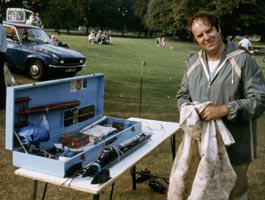 |
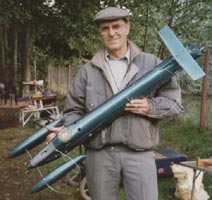 |
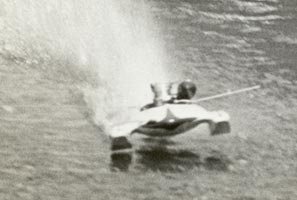 |
| 1984, St Albans | 125mph in 2000 at Farnborough | Poly-ester still with original motor |
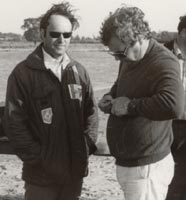 |
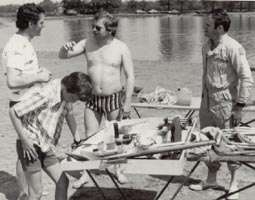 |
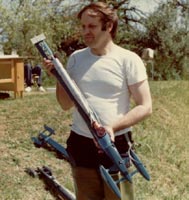 |
 |
| 1977 Hamminkel, West Germany, with Stuart Robinson | Bradwell, early 80s | 4-stroke Novice boat early 90's | |
|
Many thanks to John for all the
work in preparing this fascinating account of his racing career, and photos. |
|||
©copyrightOTW2011